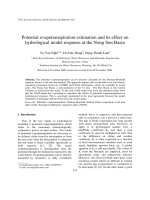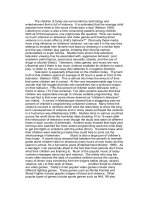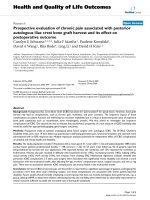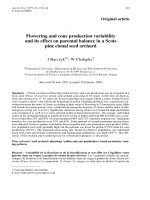Delta amino levulinic acid dehydratase (ALAD) polymorphism and its effect on human susceptibility to renal toxicity by inorganic lead
Bạn đang xem bản rút gọn của tài liệu. Xem và tải ngay bản đầy đủ của tài liệu tại đây (2.09 MB, 162 trang )
DELTA AMINO LEVULINIC ACID DEHYDRATASE
(ALAD) POLYMORPHISM AND ITS EFFECT ON
HUMAN SUSCEPTIBILITY TO RENAL TOXICITY
BY INORGANIC LEAD
ZHOU HUIJUN
(MBBS)
A THESIS SUBMITTED
FOR MASTER OF SCIENCE IN CLINICAL SCIENCE
COMMUNITY OCCUPATIONAL & FAMILY MEDICINE
NATIONAL UNIVERSITY OF SINGAPORE
2005
I dedicate this thesis to my affectionate parents, my sister and brother
for their great love and unwavering support
ACKNOWLEDGEMENTS
I would like to express my sincere thanks and gratitude to the following
people without whom this thesis would not have been possible.
To my supervisor, A/P Chia Sin Eng from the department of Community,
Occupational & Family Medicine (COFM), for his kind guidance and
insightful advice throughout the course of the study and this thesis.
I am indebted to Rachel for her work in the identification of ALAD genotype
and her constant consultation on population genetics.
I am grateful to laboratory officers in COFM which did all the analysis for
blood lead and all the renal parameters.
To the department of COFM for providing me with this opportunity to
further my exploration into the field of occupational health and
epidemiology.
To all the lecturers of the Clinical Science Program for their superb teaching
and unfailing support, and special thanks go to Professor Chan Yiong Huak
and Ms Tai Bee Choo.
I would express my heart-felt appreciation to everyone who has helped me in
one way or another in the production of my project and thesis.
Last but not least, to my best friend, Cheryl Chia Li Qin, for her constant
encouragement accompanying me through the critical time of my life.
i
TABLE OF CONTENTS
ACKNOWLEDGEMENTS ……………………………………………….….. i
TABLE OF CONTENTS …………………………………………………..… ii
SUMMARY …………………………………………………………………….v
LIST OF TABLES ………………………………………………………...…. ix
LIST OF FIGURES …………………………………………………...………xi
LIST OF APPENDICES …………………………………………………… xiv
CHAPTER ONE ······································································································ 1
INTRODUCTION···································································································· 1
1.1
SCIENTIFIC PERSPECTIVE············································································ 1
1.2
PUBLIC HEALTH PERSPECTIVE··································································· 3
1.3
HYPOTHESES ·································································································· 4
1.4
OBJECTIVES ···································································································· 5
CHAPTER TWO ····································································································· 6
LITERATURE REVIEW ······················································································· 6
2.1
BACKGROUND ······························································································· 6
2.2
OVERVIEW OF LEAD EXPOSURE ································································ 6
2.3
TOXIC KINETICS OF LEAD ··········································································· 9
2.3.1
Uptake of Lead···································································································9
2.3.2
Distribution and Retention of Lead··································································13
2.3.3 Lead Excretion and Body Lead Burden ·····························································16
2. 4
2.4.1
2.4.2
2.4.3
INDICES FOR LEAD EXPOSURE ································································ 17
Lead Concentration In Blood (PbB, μg/dl)······················································17
Lead Concentration In Bone (Pb-Bone, μg/g) ·················································20
Other Lead Indices···························································································21
2.5
THE RENAL EFFECT OF LEAD···································································· 22
2.5.1
2.5.2
Anatomy and Physiology of Kidneys································································22
Physiological Basis of Lead Toxicity ·······························································23
ii
2.5.3
2.5.4
Pathophysiology of Lead Induced Renal Injury···············································24
Renal Effect of Lead (Epidemiological Studies) ··············································26
2.6
ERYTHROPOIETIC SYSTEM AND ALAD ENZYME·································· 37
2.6.1
Disturbance of Erythropoietic System ·····························································37
2.6.2 ALAD Enzyme ··································································································38
2.7
ALAD GENE AND ITS POLYMORPHISM···················································· 40
2.7.1
Basics of Genetic Polymorphism ·····································································40
2.7.2
ALAD Gene and ALAD Polymorphism····························································42
2.8
ALAD POLYMORPHISM AND ITS EFFECT················································ 45
2.8.1
ALAD Polymorphism Distributions in Various Populations ···························46
2.8.2 Effect of ALAD Polymorphism on Lead Toxicokinetics ···································47
2.8.3
Effect of ALAD Polymorphism on Health Outcomes (Two Scenarios) ············56
2.8.4
Comprehensive Analysis of ALAD’s Effect·······················································59
2.9
PROBLEMS IN RESEARCH ·········································································· 61
CHAPTER THREE ······························································································· 67
MATERIAL AND METHOD ··············································································· 67
3.1
EPIDEMIOLOGY SECTION ·········································································· 67
3.1.1
Study Site··········································································································67
3.1.2
Study Population ······························································································73
3.1.3
Questionnaire···································································································73
3.1.4
Sample Selection ······························································································73
3.2
EXPERIMENT SECTION ··············································································· 74
3.2.1
Measurement of Renal Parameters and Blood Lead ·······································74
3.2.2
Genotype Identification····················································································75
3.3
STATISTICAL ANALYSIS ············································································· 76
3.3.1
Initial Screen of Data·······················································································76
3.3.2
Statistical Method ····························································································76
CHAPTER FOUR·································································································· 78
RESULTS ················································································································ 78
4.1
CHARACTERS OF THE POPULATION ························································ 78
4.2
ALAD SNPS & THEIR DISTRIBUTIONS ····················································· 80
4.3
BASIC RELATIONSHIPS BETWEEN BLOOD LEAD AND RENAL INDICES
(STEPWISE REGRESSION MODEL) ······································································ 82
4.4
MAIN EFFECT OF ALAD POLYMORPHISM ON BLOOD LEAD AND
RENAL PARAMETERS (GENERAL LINEAR MODEL) ········································ 90
iii
4.5
EFFECT MODIFICATION OF ALAD POLYMORPHISM (MULTIPLE LINEAR
REGRESSION)·········································································································· 93
4.5.1
HpyCH4 SNP in Intron 6 ·················································································94
4.5.2
Rsa SNP in Exon 4 ·························································································103
4.5.3
Rsa SNP in Exon 5 (Rsa39) ···········································································106
CHAPTER FIVE ································································································· 111
DISCUSSION ······································································································· 111
5.1
DISTRIBUTIONS OF ALAD POLYMORPHISMS ·······································111
5.2
EARLY BIOLOGICAL EFFECT FOR LEAD INDUCED NEPHROPATHY ·111
5.2.1
Evaluation of Uα1m, Uβ2m, URBP and TNAG·············································112
5.2.2
Evaluation of Sα1m and Sβ2m ·······································································113
5.3
5.3.1
5.3.2
EFFECT OF ALAD POLYMORPHISMS ·······················································114
Msp SNP in Exon 4 ························································································114
Newer ALAD Polymorphisms and Renal Functions ······································115
5.4
GENERAL LINEAR MODEL AND MULTIPLE REGRESSION ··················117
5.5
HEALTHY WORKER EFFECT ·····································································118
5.6
STRATIFICATION OF SAMPLE···································································119
5.7
LIMITATIONS ······························································································ 120
5.7.1
Lack of Measurement of Classical Renal Function Parameters····················120
5.7.2
Lack of Measurement of Body Lead Burden ··················································120
5.7.3
Small Sample Size ··························································································121
CHAPTER SIX ···································································································· 123
CONCLUSIONS AND RECOMMENDATIONS ············································ 123
6.1
CONCLUSION······························································································ 123
6.2
RECOMMENDATIONS················································································ 124
6.2.1
Choosing Appropriate Exposure and Outcome Parameters··························124
6.2.2
Choosing Appropriate Statistical Method······················································125
6.2.3
Investigating Other ALAD Snps or Genes ·····················································125
6.2.4
Identifying the Thresholds for Lead Toxicity and ALAD Polymorphism ·······125
6.2.5
Follow-up Study ·····························································································126
REFERENCES····································································································· 127
iv
SUMMARY
Introduction: In spite of the drastic decrease in lead exposure, the public is still exposed
to various sources of lead which can contribute to a blood lead level toxic to human body.
As important human organs, kidneys are very sensitive to lead exposure and the lead
induced nephropathy has been the main topic of lead intoxication for centuries. The new
researchers direct their efforts to establish the causal relationship between low level lead
exposure and the subclinical alternation in renal functions. Ther efore, the identification
of sensitive and specific early biological effects (EBE) arises as the highest goal of
modern lead research since classical parameters have been proven useless for this purpose.
At the meantime, the gene-environment interaction occurring between ALAD
polymorphism and lead confers extra risk to the population with certain alleles during
lead exposure. The attempt to identify the susceptible population to protect is of great
public health importance.
Objectives: 1) To get some insights about the distributions of ALAD polymorphisms in a
Vietnamese population; 2) To identify and recommend sensitive and specific early
biological effects for lead-induced impairment in renal function; 3) To identify genetic
alleles that are susceptible to lead exposure.
Materials and Methods: This is a cross-sectional study investigating a population of
active healthy lead workers from Vietnam whose participation was totally voluntary. Out
of a total of 323 production workers from a lead battery manufacturer, 248 individuals
were included in the study.
v
PbB (blood lead) was chosen as exposure index. Uα1m (urinary α1-microglobulin),
Uβ2m (urinary β2 microglobulin), URBP (urinary retinol binding protein), Ualb (urinary
albumin), TNAG (total N-acetyl-beta-D-glucosaminidase in urine), Sα1m (serum
α1-microglobulin), Sβ2m (serum β2 microglobulin), ALAU (urinary amino levulinic acid)
were chosen as outcome indices. Msp & Rsa in exon 4, Rsa in exon 5 (Rsa39), HpyIV &
HpyCH4 in intron 6, Sau3A in intron 12, which were not in linkage disequilibrium, were
selected to represent 46 ALAD SNPs. Each participant had their genotype, exposure and
outcome variables measured.
General linear model and multiple linear regression were used to find out 1) Is there any
difference in means of blood lead or renal parameters between genotypes of each ALAD
SNP after adjusting for known confounders? 2) Does the increase of PbB cause the same
increase of renal parameters across genotype subgroups within each ALAD SNP studied?
Results: The population, with a mean age of 39.3 years and mean exposure duration of 15
years, was occupationally exposed to a modest level of lead reflected by PbB (mean,
24.39 μg/dl).
The Msp allele frequencies of ALAD polymorphism were 0.959 and 0.041 for ALAD-1,
ALAD-2 respectively, similar to the frequencies reported in other Asian populations. For
other ALAD SNPs, this was the first epidemiological study to report their allele
frequencies. The frequency of Rsa-1 was 0.467 and that of Rsa-2 was 0.533. Rsa39 SNP
had 46.7% Rsa39-1 allele and 53.3% Rsa39-2 allele. The majority of HpyCH4 alleles
were HpyCH4-1 (0.942) and the rest were HpyCH4-2 (0.058). The frequency of HpyIV-1
was 0.852 and that of HpyIV-2 was 0.148. Sau3A-1 took 76.9% and Sau3A-2 took 23.1%
vi
of all Sau3A alleles. The genotype and allele distributions followed Hardy-Weinberg
Equilibrium for each ALAD polymorphism.
Stepwise multiple linear regression models explored and quantified the relationships
between PbB and each outcome parameter. In the models of variables representing renal
function, PbB was the significant predictor for TNAG (p=0.004), Uα1m (p=0.043), Uβ2m
(p=0.043) and URBP (p=0.042). TNAG seemed specific to lead exposure for two
variables selected by the stepwise process were PbB and exposure duration, both
measuring exposure level. PbB was also the significant predictor for ALAU (p<0.001).
Ualb, Sα1m and Sβ2m were not correlated to blood lead.
The only significant finding in GLM analysis was that the mean blood lead of Rsa39 2-2
(26.7 μg/dl) was significantly higher than that of Rsa39 1-1 (22.8 μg/dl) and Rsa39 1-2
(21.7 μg/dl) groups after adjustment for age, sex, BMI and exposure duration (p=0.032).
Multiple linear regression aiming at the effect modification of SNPs illustrated that
HpyCH4 could change the association of PbB with Uα1m (p=0.002), Uβ2m (p<0.001)
and URBP (p=0.008). In respond to 1 μg/dl increase of PbB, Uα1m, Uβ2m and URBP
increased 1.042 mg/gCr, 1.069 μg/gCr and 1.038 mg/gCr respectively for HpyCH4 1-1
homozygotes whereas, for HpyCH4 1-2 heterozygotes, Uα1m, Uβ2m and URBP
increased 1.009 mg/gCr, 1.012 μg/gCr and 1.009 mg/gCr, less than those for HpyCH4
1-1.
Conclusion: The distribution of classical ALAD polymorphism in Vietnamese is similar
to the data reported for other Asian populations. This is the first time that that the
vii
distributions of Rsa in exon4, Rsa in exon 5, HpyCH4 and HpyIV in intron 6, and Sau3A
in intron 12 are being reported.
Uα1m, Uβ2m, URBP and TNAG are possible EBEs for renal function induced by lead
exposure.
The newer ALAD polymorphism, HpyCH4 SNP in intron 6, can change the function of
lead with regard to renal function. The exonic polymorphisms Rsa in exon 4 and exon 5
(Rsa39) can change the lead’s effect on ALAU, an intermediate product in heme
biosynthesis pathway. These facts suggest that ALAD SNPs other than classical MSP
ALAD polymorphism need to be considered in order to elucidate the effect of ALAD
polymorphism on lead exposure.
Multiple linear regression model searching for effect modification of ALAD
polymorphism is a better statistical tool for ALAD study compared with General linear
model.
viii
LIST OF TABLES
Table 2.1 ……………………………………………………………………………...46
Alpha-aminolevulinic acid dehydratase genotype Distributions in previous studies
Table 4.1 …………………………………………………………………………...…78
Characters of the population in study
Table 4.2 ………………………………………………………………………...…... 79
Basic characters of the population by SNPs
Table 4.3 …………………………………………………………………...………... 80
Distributions of blood lead and renal parameters
Table 4.4 ………………………………………………………...…………………... 81
Characters of 6 ALAD SNPs in study
Table 4.5 …………………………………………………………...………………... 81
Distributions of 6 ALAD SNPs
Table 4.6 ………………………………………………………………………...…... 83
Stepwise regression model of Ua1m_Log
Table 4.7 …………………………………………………………………………...... 84
Stepwise regression model of Uβ2m_Log
Table 4.8 ………………………………………………………………...…………... 85
Stepwise regression model of URBP_Log
Table 4.9 …………………………………………………………………...………... 86
Stepwise regression model of TNAG_SQRT
Table 4.10 ……………………………………………………………………………87
Stepwise regression model of ALAU_Log
Table 4.11 ……………………………………………………………………………. 90
Comparisons of blood lead and renal parameters between Msp genotypes
Table 4.12 ………………………………………………………………………...…. 90
Comparisons of blood lead and renal parameters between HpyCH4 genotypes
Table 4.13 …………………………………………………………………...………. 91
Comparisons of blood lead and renal parameters between HpyIV genotypes
ix
Table 4.14 ………………………………………………………………...…………. 91
Comparisons of blood lead and renal parameters between Sau3A genotypes
Table 4.15 ………………………………………………………………...…………. 92
Comparisons of blood lead and renal parameters between Rsa genotypes
Table 4.16 ……………………………………………………………..…………….. 92
Comparisons of blood lead and renal parameters between Rsa39 genotypes
Table 4.17 ………………………………………………………………………...…. 95
MLR model of Uα1m_Log for HpyCH4 SNP
Table 4.18 …………………………………………………………………...……..... 97
MLR model of Uβ2m_Log for HpyCH4 SNP
Table 4.19 ………………………………………………………………………..….100
MLR model of URBP_Log for HpyCH4 SNP
Table 4.20 ………………………………………………………………………...…104
MLR model of ALAU_Log for Rsa SNP
Table 4.21 …………………………………………………………………………108
MLR model of ALAU_Log for Rsa39 SNP
x
LIST OF FIGURES
Figure 2.1 ………………………………………………………………………...……...10
Movements of lead particles in lung
Figure 2.2 ………………………………………………………………………...……...11
Relationship between air lead and blood lead
Figure 2.3 ………………………………………………………………………...……...14
Toxicokinetics of Lead
Figure 2.4 ……………………………………………………………………...……….. 21
Biomarkers of lead exposure
Figure 2.5 ……………………………………………………………………...……….. 22
Structure of Kidney
Figure 2.6 ……………………………………………………………………...……….. 23
Physiology of Nephoron
Figure 2.7 ………………………………………………………………………...…….. 25
Consequences of excessive lead exposure
Figure 2.8 ………………………………………………………………………...…….. 43
Structure of ALAD gene
Figure 2.9 ………………………………………………………………………...…….. 54
Serum lead concentration as a function of cumulative percentage of sample
Figure 3.1.1 …………………………………………………………………...……...….68
Lead Battery Manufacturing Process
Figure 3.1.2 ………………………………………………………………...…………... 69
Stacking of lead accumulator (1)
Figure 3.1.3 ……………………………………………………………………….... …..69
Stacking of lead accumulator (2)
Figure 3.1.4 ………………………………………………………………...…………... 70
Assembly of lead accumulator (1)
Figure 3.1.5 ………………………………………………………………...…………... 70
Assembly of lead accumulator (2)
xi
Figure 3.1.6 ……………………………………………………………...…………. ….71
Welding of lead accumulator (1)
Figure 3.1.7 ………………………………………………………………...………….. 71
Welding of lead accumulator (2)
Figure 3.1.8 ………………………………………………………………...………. .….72
Charging of lead battery
Figure 3.1.9 ……………………………………………………………...……………... 72
Final product--lead battery
Figure 4.1 …………………………………………………………………...………….. 82
Linear relationship between Uα1m_Log and PbB
Figure 4.2 …………………………………………………………...………………….. 83
Linear relationship between Uβ2m_Log and PbB
Figure 4.3 …………………………………………………………………...………….. 84
Linear relationship between URBP_Log and PbB
Figure 4.4 …………………………………………………………………...………….. 85
Linear relationship between TNAG_SQRT and PbB
Figure 4.5 …………………………………………………………………...…………. .86
Linear relationship between ALAU_Log and PbB
Figure 4.6 …………………………………………………………………...………….. 87
Relationship between Ualb_Log and PbB
Figure 4.7 ……………………………………………………………………...……….. 88
Relationship between Sα1m_Log and PbB
Figure 4.8 ……………………………………………………………………...……….. 89
Relationship between Sβ2m_Log and PbB
Figure 4.9 …………………………………………………………………...………….. 94
Regression lines of urinary α1 microglobulin versus blood lead by HpyCH4
genotypes (Y, original Uα1m_log; X, blood lead).
Figure 4.10 ………………………………………………………………...…………… 96
Regression lines of urinary α1 microglobulin versus blood lead by HpyCH4
genotypes after adjustment for age, exposure duration, gender and BMI
xii
Figure 4.11 ……………………………………………………………………….……. 97
Regression lines of urinary β2 microglobulin versus blood lead by HpyCH4
genotypes
Figure 4.12 ……………………………………………………………………….…….. 99
Regression lines of urinary β2 microglobulin versus blood lead by HpyCH4
genotypes after adjustment for age, exposure duration, gender and BMI
Figure 4.13. …………………………………………………………………………… 100
Regression lines of retinol binding protein versus blood lead by HpyCH4 genotypes
Figure 4.14. …………………………………………………………………………… 102
Regression lines of urinary retinol binding protein versus blood lead by HpyCH4
genotypes after adjustment for age, sex, exposure duration and BMI
Figure 4.15…………………………………………………………………………….. 103
Regression lines of urinary amino levulinic acid versus blood lead by Rsa genotypes
Figure 4.16 …………………………………………………………………..………... 105
Regression lines of urinary amino levulinic acid versus blood lead by Rsa genotypes
after adjustment for age, sex, exposur e duration and BMI
Figure 4.17 ……………………………………………………………………..…. …..107
Regression lines of urinary amino levulinic acid versus blood lead by Rsa39
genotypes
Figure 4.18 ……………………………………………………………………..……... 109
Regression lines of urinary amino levulinic acid versus blood lead by Rsa39
genotypes after adjustment for age, sex, exposure duration and BMI
xiii
LIST OF APPENDICES
Apprendix I:
Questionnaire (English Version)
Apprendix II:
Questionnaire (Vietnamese Version)
Apprendix III:
Abbreviations
xiv
CHAPTER ONE
INTRODUCTION
1.1
SCIENTIFIC PERSPECTIVE
In spite of the drastic decrease of lead (Pb) exposure in recent years, lead
intoxication is still an important public health issue worldwide because of the
ubiquitous existence of lead in the environment. In 2001, the global disease burden
from lead-induced disease was estimated to be 0.4% of all deaths and 0.9% of
disability-adjusted life years (WHO, 2002).
In response to the decrease of lead exposure, present researchers shifted their
focus to the consequence of long-term low-level lead exposure (Muntner et al., 2003).
The acute cases of lead intoxication, popularly seen in old days, are unlikely to
happen in modern time. The exposure to mild or modest lead levels caused damage,
which can usually be defined as normal by current clinical standards. The subclinical
alternation in function and structure of human organs was hardly detected in their
early stage during which it is still reversible. In the case of kidney, classical renal
function parameters creatinine clearance (CCr), blood urine nitrogen (BUN) and
serum creatinine (SCr) can only be abnormal when more than 50% of the nephrons
are damaged (Loghman-Adham, 1997). It is always too late for medical intervention
at this stage of disease development. Both clinical doctors and epidemiologists
appreciated the urgent need to identify sensitive and specific early biological effects
(EBE) indicators for renal damage caused exclusively by lead exposure. The
successful identification of renal EBEs can enable doctors in occupational medicine to
monitor the early change of renal function to prevent from advancing into clinical
disease.
1
In the area of environmental health, interest is increasing in the role of
variations in the human genome (polymorphisms) in modifying the effect of
exposures to environmental health hazards (often referred to as gene–environment
interaction), which render some individuals or groups in the population more or less
likely to develop disease after exposure. Two primary benefits of incorporating
genetics into the existing environmental health research framework are, 1) the ability
to detect different levels of risk within the population, and 2) greater understanding of
etiologic mechanisms. Both offer opportunities for developing new methods of
disease prevention (Kelada et al., 2003). Likewise, present lead study comes into a
new era during which personal genetic profile has to be taken into account.
Some
studies
have
shown
that
the
genetic
polymorphisms
of
delta-aminolevulinic acid dehydratase (ALAD), vitamin D receptor (VDR) and nitric
oxide synthase (NOS), were able to alter the pharmaceutical dynamics of lead so as to
change the human susceptibility to lead exposure (Wetmur et al., 1991; Smith et al.,
1995; Weaver et al., 2003), especially ALAD polymorphism, which has already
demonstrated such gene (ALAD gene) and environment (lead exposure) interaction in
quite a few studies (Chia et al., 2004; Alexander et al., 1998; Sithisarankul et al.,
1997). Considering the importance of ALAD enzyme in the biological kinetics of lead
(Bergdahl et al., 1997), ALAD gene, with more than 100 single nucleotide
polymorphisms (SNPs), is the one worth much attention from scientific community.
The common ALAD polymorphism, Msp SNP in exon 4, is not enough to explain all
the confusion encountered so far. More studies about ALAD polymorphisms are in
need to advance the current understanding of gene–environment interaction and to
identify the populations at higher risk.
2
1.2
PUBLIC HEALTH PERSPECTIVE
For the developing countries in Southeast Asia where the rapid
industrialization is under way, the economic development not only put more and more
people into lead related industries like battery manufacture, but also contributed to air
contamination which further exposed the public to the metal. In Singapore alone, it
was estimated that 786 workers engaged in 49 companies were occupationally
exposed to lead (Chia et al., 1993). The situation of lead exposure is supposed to be
worse in relatively poor countries like Vietnam, because “the main environmental
health problems are exacerbated by poverty, illiteracy and malnutrition, and include:
indoor and outdoor air pollution, lack of access to safe water and sanitation, exposure
to hazardous chemicals, accidents and injuries” (the Bangkok Statement; WHO 2002).
However, studies targeting populations from these countries were few except
Korean and Taiwan. The International Conference on Environmental Threats to the
Health of Children: Hazards and Vulnerability held in Bangkok, Thailand, March
2002, have drawn some attention to the lead threat in Southeast Asia. In recognition of
the significance of lead exposure, Ministry of Industry in Vietnam, in collaboration
with National University of Singapore, launched this joint project to get a picture of
lead poisoning among lead workers in Vietnam.
3
1.3
HYPOTHESES
1) The ALAD polymorphism distribution in Vietnamese is similar to Asian
populations.
2) Urinary concentration of low molecular weight (LMW) protein and
lysosomes are better EBEs for early renal damage caused by lead than
classical renal function indices.
3) ALAD SNPs other than like Msp SNP in exon 4 (the classical ALAD
polymorphism) are able to affect the lead toxicity with regard to renal
function as outcome measurements.
4
1.4
OBJECTIVES
1) To examine ALAD polymorphism distribution in a new population in Asia
(Vietnam)
2) To establish if there is an association between lead exposure and renal
function reflected by urine concentration of low molecular weight protein
and lysosome.
3) To examine the interaction between ALAD polymorphism and lead
exposure (gene-environment interaction) so as to identify susceptible
ALAD alleles which confer more risk to people with these alleles during
lead exposure
4) To identify and recommend sensitive and specific EBEs for renal function
impairment induced by lead exposure by seeking affirmative dose-effect
and/or dose-response relationship between blood lead and candidature renal
parameters.
5
CHAPTER TWO
LITERATURE REVIEW
2.1
BACKGROUND
Lead is one of heavy metals that remain health threats to human beings.
Because of the ubiquitous existence of lead in the environment, the general population
is more or less exposed to lead. The people hired in lead related industries had an even
higher lead exposure. Although the intensity of exposure level has decreased
substantially in recent decades, with ever decreasing blood lead that is toxic to human
being, the current safe standard of lead exposure was not considered safe anymore,
especially for the populations who are specifically venerable to lead effect, for
instance, children, women in pregnancy and the persons with susceptible genotypes.
With the development of molecular biology, the knowledge of genetics has
been incorporated into the environmental health research. In the case of lead study,
individual genetic profile has to be taken into account in investigating the toxic effect
of lead. According to genetic theories, people with certain gene are more subject to
some diseases than others. Likewise, the gene encoding δ-amino levulinic acid
dehydratase (ALAD), an enzyme actively involved in lead kinetics, could make a
portion of population with some ALAD genotype more susceptible to lead toxicity. As
such, these people need special attention and protection. It is of public health
importance to figure out which allele is the susceptible one and how it operates in
human body.
2.2
OVERVIEW OF LEAD EXPOSURE
In general, the lead exposure is decreasing worldwide, especially in developed
countries such as the countries in Europe and USA. These countries launched a series
6
of initiatives and programs to reduce lead contamination. As a result, dramatic decline
in lead concentration in blood (PbB) of general population has been achieved.
The large scale surveys (National Health And Nutrition Examination Survey,
NHANES) conducted in USA evidently showed a constant decline in blood lead in
general population as well as in subgroups by age. During the period of NHANES II
(1976-1980, n=9832), the average blood lead levels dropped approximately 37% (5.4
μg/dl) from 1976 through 1980 (Annest et al., 1983). Then from NHANES II to phase
1 of NHANES III (1988-1991, n=12119), the geometric mean (GM) of PbB dropped
78% from 12.8 to 2.8 μg/dl. The GM of PbB in children aged 1 to 5 years declined
77% from 13.7 to 3.2 μg/dl for non-Hispanic white children and 72% from 20.2 to 5.6
μg/dl for non-Hispanic black children. The prevalence of PbB of 10 μg/dl
or greater
in this group declined from 85% to 5.5% for non-Hispanic white children and from
97.7% to 20.6% for non-Hispanic black children (Pirkle et al., 1994). This declination
continued in the years followed. The number of children with confirmed elevated PbB
of 10 µg/dl or greater steadily decreased from 130,512 in 1997 to 74,887 in 2001
(Meyer et al., 2003). The similar declination occurred too in Belgium, which has seen
a decrease of median PbB from 17 to 7.8 μg/dl since 1978 until 1989 (Ducoffre et al.,
1990).
Lead in gasoline was a proven cause for elevation in PbB for the public and
the effect of its removal was impressive and convincing (Pirkle et al., 1994; Bono et
al., 1995; Annest et al., 1983). Annest et al (1983) pointed out that the main cause for
the fall of PbB in NHANES II was the elimination of lead from gasoline which had
happened as early as 1970s. Italy’s experience directly substantiated that the reduction
of lead in gasoline greatly improved the quality of atmosphere and was strongly
associated with the decline in PbB (Bono et al., 1995). The dramatic decrease in PbB
7
has been achieved in Thailand, Philippines, India, and Pakistan since they reduced
their use of lead in gasoline in 1990s (Suk et al., 2003). In Brazil, lead was withdrawn
from gasoline by the end of the 1980s (Paoliello and De Capitani, 2005) and the
decline in PbB was observed.
In occupational settings, stringent health measures had been taken to protect
workers from lead exposure. In Korea, the incipient efforts taken were, promoting the
awareness of the hazards of lead exposure, monitoring zinc protoporyphin (ZPP) level
and introducing a respiratory protection program. A computerized health management
system was developed subsequently and lead in blood and air were measured and
controlled. The latest measure was to monitor bone lead level. These serial efforts
resulted in a 17.7 μg/dl decrease in mean PbB of lead workers from 1988 to 1998 (Lee,
1999).
Although the exposure level kept going down in overall, human beings still
live with various lead sources which can contribute to a toxic blood lead level. Food
and water are main media containing lead. In USA, the food, in the place of the lead
polluted air, became the main source of lead. In Japan, the daily lead intake for
non-smoking women was 6.2 μg/day (GM) (Watanabe et al, 1995). In Korean, the
geometric mean of dietary lead intake in four large cities (Seoul, Pusan, Chunan, and
Haman) was 20.5 μg/day (Moon et al., 1995), 12% of which came from boiled rice.
This value was 30.4 μg/day for Taiwan (Ikeda, 1995) where herbal drug consumption,
milk consumption, drinking water, lead recycling plant made sources of lead (Liou et
al., 1996). For Chinese, the mean of daily lead intake was as high as 86.3 μg/dl (Chen
and Littlejohn, 1993).
The worse thing was that the current evidences suggested, the threshold of
blood lead level is very low yet unknown. The PbB level of 10 μg/dl, the current safe
8
level set by CDC, USA, is not considered safe any more. As for the effect on the
neurobehavior of children in development, there did not seem to be a threshold of PbB
(Schwartz, 1994). Regarding renal function, positive correlation was found between
PbB and Creatinine Clearance (CCr), Blood Urine Nitrogen (BUN) in a female
population (n=1016) with a mean PbB below 10 μg/dl (Staessen et al., 1992).
In contrast to the declining trend of lead exposure, countries in Southeast Asia
evidenced the growing exposure to lead due to rapid industrialization and urbanization
going on in the region (Suk et al., 2003). One of byproducts of the prosperity is the
deterioration of air quality. Based on the data on lead concentration in air and dusts
dating back to 1980, Dr. Mohmood Khwaja reported that the lead exposure increased
over time in Pakistan, which was supposedly attributed to leaded petrol use (Khwaja,
2002).
2.3
TOXIC KINETICS OF LEAD
Lead kinetics can be roughly divided into 3 steps, uptake from outside lead
sources, distribution among human systems and clearance from human body. Out of 3
steps is the lead distribution the most important step for the effect of lead mainly
depends on the amount available to the individual organs.
2.3.1
Uptake of Lead
Lead enters human body mainly through ingestion and inhalation, the two
channels playing predominant roles in most of exposure situations. Many factors can
affect the efficiency of absorption.
2.3.1.1 Inhalation
Inhalation is the major channel for the entry into human body of lead air which
9









